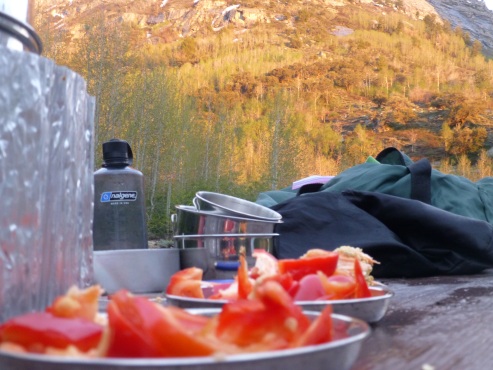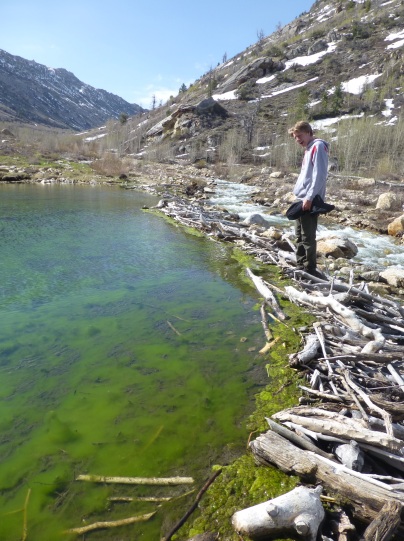The story of the Himalayan Snowcock’s existence in North America seems too fanciful to be true, and as we scrambled up snow and scree on an endless hillside in far-out Nevada, part of my mind started to wonder if we had been duped.
We knew the history. In the early 1960s, Nevada Fish & Game officials had noticed the similarity of the Nevada mountain landscapes to the Himalayas. With no further ado they convinced the President of Pakistan to catch a number of Snowcocks, a prized game bird in the high mountains of South and Central Asia, and ship them to a farm in Nevada where a captive breeding program was attempted. Over a 15-year period the program managed to release a few thousand birds into the wild in Nevada, but they never managed to establish a strong population, and needed to be propped up constantly by costly captive rearing of birds. The program was shuttered.
This could have been the end of the Himalayan Snowcock’s curious story in the US, but two trends intervened. First, a small population of a few hundred birds managed to scratch out a stable niche in the Ruby Mountains, which are about as remote and rugged as mountains get in the Lower 48. They’re not particularly high compared to the Colorado peaks; they don’t have sheer cliffs like Yosemite; and they don’t have the aesthetics and fame of Glacier or the Wyoming ranges. They’re just a glacially-carved, brutally steep, cold, hard range rising out of the flats of remote eastern Nevada. The biggest city you can get to within five hours of fast driving is Elko, home to twenty thousand souls, a gold mining industry, and several legal active brothels. This is where the Himalayan Snowcock, fresh off the plane from the mythical valleys of Hunza in the Pakistan Himalaya, decided it could live.
The second trend was the rise of birding. Nothing can bring people to a remote location as effectively as a bird that is uniquely there. We first heard about the Snowcocks in the Rubies when reading about listers Greg Miller and Al Levantin chasing them from a helicopter in The Big Year. The image of these reclusive mountain birds stayed with us, and when we found ourselves crossing the country from San Francisco to Boston on a frenetic straight-line trip to make it to our summer jobs, we knew we had to carve out time to see what we could see in the Rubies.
All of this seemed pretty hypothetical, though, when we were on the mountain with no birds in evidence. Had we gone too far this time, based on a few bits of flimsy online research?
Our plan, such as it was, had worked out pretty well so far. Alex and I woke up in Berkeley and drove the 550 miles over the Sierras, through the basins and ranges of Nevada, and straight up into the rubies. The mountains were intimidating as we arrived in the evening: dark gray rock with long shadows forming imposing walls up the narrowing valley, rivers that looked too fast to cross on foot, heavy skies. We drove as far as we could and found that the road ended in a hip-deep snowbank. This was where we would start walking the next morning. We backtracked to a campsite, and as we made and ate dinner, the clouds shifted and the sun bathed the mountain walls behind us a brilliant orange. A good omen.

The main challenge we knew we were facing was that the Snowcocks can only be seen early in the morning- before about 8am- and only at elevations a few thousand feet above the road. This meant that we would have to wake up early and forge a route uphill quickly enough to catch the Snowcocks before they became invisible. In the summer the road is open all the way to a certain trailhead that gives hikers a clear shot at the birds, although it still requires an early wakeup. At the end of the May, when we visited, this trail and all high trails in the Rubies are inaccessible. So we would need to get up before dawn, drive to the end of the road, break our own trail way up the mountain, and find the birds- all in a race against the clock.
We woke up in the pitch dark. Let’s do this.
The first tough barrier came quickly. We hiked up the hard-packed snow of the road easily, but then had to turn off the road and start up the mountainside. We bushwhacked through this alpine forest and found ourselves in a small river valley, featuring a freezing, fast-moving torrent. We immediately realized that we couldn’t wade across it. But it stood between us and the birds. We filled the river downstream and found a log that had fallen across, providing a partly disintegrated, sketchy way across. After scouting some more, we decided that the log was our only chance; gripping our binocs tight and swallowing our fears, we inched across it one by one, and both managed to find the other shore with only one soaked foot between us.


Now it was only up. We quickly made it through the rest of the thick forest, only to stumble onto a steep, rocky, flaky hillside. We picked our way up gulches and goat-trails, trying to take advantage of any ribs of solid exposed rock to scramble straight up. We moved fast, pushing ourselves, but the sun relentlessly advanced, and the mountain did not give ground easily. We started hitting snow and passed the last of the bushes, with only snow, ice, rock, and occasional pines above us.
And, hopefully, Himalayan Snowcocks.
We hiked up through foot-deep snow, each step sucking away energy. It was still cold, but we were burning with the exercise and the thrill of the search. Higher. Higher. The mountain was humbling in its impassivity to our toil. The clock passed eight, and the sun was bright in the clear, thin air. The views improved with each step, revealing a new brutal sharp ridge, a new hanging valley between peaks. But still no birds. We started to shoot the sideways glances at each other that every birder understands, but no one wants to vocalize. Were we up there looking for something that wasn’t there?
And then a mystical sound came floating over the snow from the high ridges. The sound brought me back to lying in a cedar-built cottage on a northern lake at midnight, listening to the sounding and cackling of loons casting their spell over the water and the woods. At the same time it reminded me of creeping across vast scree slopes in the Denali taiga, resounding with the pinging calls of small Pikas living in the rocks. We looked at each other and knew that we were both feeling the deep gratitude of being in a truly wild place that we did not understand, and yet moving through it, getting closer to our goal.

We kept pushing up the mountain and started hearing the high, evocative whistle more often. Suddenly, as I had my head down watching my trudging feet, Alex gasped as I jolted up to catch the very backside of a game bird disappearing over a snow ridge, way up and over from our position. Might have been a Ptarmigan. Might have been something else. We gave chase.
By the time we made it over the ridge, there was no sign of the bird. And our minds started playing the games they always do when a hard-earned bird barely gets away- trying to convince ourselves that we were sure of what we saw, that it was good enough to list, that we were satisfied with the sighting. We stood for a few minutes, scanning, listening. Nothing.
And then the whistle came again, from high above us, and reinvigorated, we pressed on. The air was so thin and cold, then sun so bright, that we knew we had passed out of the normal world. We were hanging way up above a valley in the Nevada mountains, absolutely off trail, guided only by the ethereal calls of a bird from the High Himalayas.
And then, as we worked out way up a snow ridge with space falling away to our right, the birds came. Three perfect Himalayan Snowcocks, robust and powerful, swooped onto an exposed rock rib a hundred yards below and across from us. We had a perfect line of sight, and they sat in the sun, and for a full minute we stood in the snow and stared at them and said nothing.
All you ever get is a few moments of perfection. And you have to work hard for them; you have to bring a single-minded focus that makes barriers seem smaller than they really are, along with a creativity that allows you to circumvent them. You have to wake up earlier than anyone on vacation ever should, and be cold and hungry and risk flat tires and get your boots wet. But it is so incredibly worth it.
After getting our fill, we decided to try to get closer to the birds by climbing up further and gaining another snow spur that could take us straight in the direction of their rock. We managed to close about half the distance before the birds spooked, and got some incredible views of the striking plumage and bulk of the Snowcocks: the strong chestnut stripes on the white head and neck, the mottled back, the powerful overall appearance. They are truly beautiful birds, and fully at home in these rugged mountains so far from their homeland. We worked our way back towards our original trail, trying to follow where we had seen one of them fly, and managed to get a few more good views.

We took a rest on a rock flat, utterly satisfied, dizzy with the altitude and the successful bird-finding, and then slid on our butts straight down the same snow trail we had come up, covering in a few minutes what had taken an hour to climb. A little treat after all the work. And then it was back to picking our way down the flaky rocks, and then through the bushes, and the forest, and back across the log bridge that seemed even more widely sketchy in the full light of day, and back down the snow road to the car. A few hours later we were gassing up our car, the immortal ‘02 Camry, at a dusty pump in one of the Nevada basins, and we just looked at each other and laughed. There was probably no one within a hundred miles who would understand why we did what we did. But we knew why.
We had gotten the bird.

